Profane
Freemasons use a lot of old-English in their rituals and conversations. One example of this is the term profane that is used when referring to someone who is not a mason. Unfortunately the use of the word by the average English-speaker has changed over the years. Today it is considered by non-masons to be derogatory. It is commonly understood to mean disrespectful, irreverent, obscene or vulgar.
Clearly though that is not the intended meaning as it is understood by Freemasons. The word is derived from the Latin “pro” meaning before, and “fanum” which means temple. Thus, someone profane is one who is “outside the temple”, or uninitiated.
It might be reasonable for Masons today to only use this term exclusively inside their own lodges, or when conversing with other Freemasons, in order to avoid unintended potential offense of non-Masons. Therefore, caution is advised.
Knights of Saint Andrew
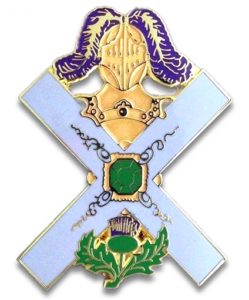
The Knights of St Andrew (KSA) are a Masonic service group. It is specifically part of the Scottish Rite. It was founded in 1993 in the Valley of Tulsa, Oklahoma, by the late, Ill. Weldon Good, 33. The by-laws stated that the Knights of St. Andrew are a “Black Cap” group. A member who receives the honor of KCCH – Knights Commander of the Court of Honor – can not hold an office or vote but they can continue to work and assist. The main duties of the Knights of St. Andrew were and are, to assist, as needed, during a reunion and to be available to the Valley’s General Secretary for any assigned duties.
Initially there were chapters only in Oklahoma, in Tulsa, Guthrie and McAllister. Later on it kept growing and additional chapters were founded throughout the Southern and Northern jurisdictions of the Scottish Rite. There are now chapters in over 180 valleys. Some Chapters have elected to use the names, Order of the Thistle, or Scots Guards. Not only the names and the logos, but also the dress differs from valley to valley. Some use kilts and Glen Gharry caps, while others prefer the black Scottish Rite caps and suits or tuxedos.
One thing all Knights of St Andrew chapters have in common is that it is an organization of and for Black Cap Scottish Rite Masons designed to assist with and give service to their Valley. It is mostly joined by members who go beyond simply attending meetings but are deeply involved and happy to serve.
More Info:
https://www.knightsofstandrew.info
DeMolay
![]()
DeMolay is a Masonic youth organization that was founded in Kansas City, MO in 1919 and is named in honor of Jaques de Molay, the last Grand Master of the Knights Templar. DeMolay is open for membership to all young men between the ages of 12 and 21 who acknowledge a higher spiritual power. There are currently about 15,000 members worldwide. Each chapter is sponsored by a local Masonic lodge. Their members then provide adult supervisors and leadership for that particular chapter.
The organization offers a two degree system. The first one is for the initiation of new members, and the second for members who become officers. Participating in the degrees and becoming an officer allow members to develop leadership, organizational and public speaking skills. It fosters self confidence and surrounds the members with a group of supportive and like-minded people.
DeMolay teaches seven core values, which are called cardinal virtues, as the basis of good character. They are: Filial Love, Reverence for Sacred Things, Courtesy, Comradeship, Fidelity, Cleanliness and Patriotism.
Famous alumni of the organization include: Walt Disney, Mel Blanc, Bill Clinton, John Wayne, John Steinbeck, Pete Rose, Fran Tarkenton and Burl Ives.
More Info:
https://en.wikipedia.org/wiki/DeMolay_International
https://demolay.org
Cable Tow
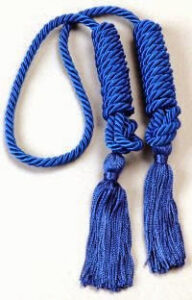
The cable-tow is a length of rope that was used by our operative Masonic forefathers for a multitude of purposes. They used it to bind together heavy objects on floats or rafts, to ensure safe transport to the worksite. It was also used to secure the workers at the job sites. The longer the rope, the higher the worker was able to stand at the building site. This indicated a more advanced and experienced workman.
In speculative Freemasonry the cable-tow is used to dress a candidate during the initiative degrees. It symbolizes several different and unrelated meanings. One thought is that the degrees represent a symbolical rebirth of the man into a Mason, the rope therefore represents an umbilical cord that binds the candidate to the fraternity.
Another way to interpret it is to look at the rope as a physical bond or shackle that the candidate throws off once he becomes a Mason by completing the obligation and pledging on his honor to uphold the principal tenants of Freemasonry. Brotherly love being stronger than any physical restraint.
This physical bond can also be viewed as the tyranny of passions, ignorance and spiritual slavery that man suffers under before being liberated by becoming enlightened through Freemasonry.
These are just some of the many possible interpretations of this ancient symbol.
English Football’s Ties with Freemasonry
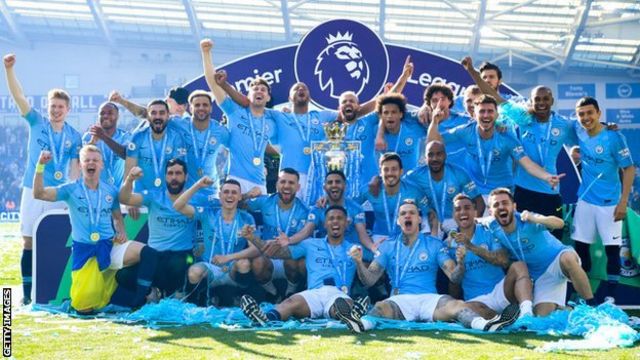
English football’s association with Freemasonry goes back to 1863 when the Football Association was formed at the Freemasons’ Tavern in London – on Great Queen Street in London, now the New Connaught Rooms next door to Freemasons’ Hall.
After the very first match under the new football governing rules way back in January 1864, a toast was drunk – how very Masonic in itself – to ‘success to football, irrespective of class or creed’.
There are a number of Masonic Lodges named after their famous teams – Anfield Lodge, No. 2215, Everton Lodge No. 823 and more recently the Football Lodge No.9921.
There have long been myths about the colors, or rather colours, of the professional soccer team “Machester City FC” of the English Premier League. In 1894 the club was in a financial crisis and was bailed out by Masons, who asked that in return the team wear the Masonic colour of blue.
“Sidney Rose was a medical doctor and a Mancunian(Manchester) Freemason, he had been a supporter of Manchester City since the 1920s. He was appointed the Director of the club from 1966 to 1986, after resigning as director he was given the prestigious position of life Vice President until his dead in 2014. He revealed that: “The real founders of the Club became involved in 1894 when there was sort of financial crisis, and that they were Masons, or certainly had close Masonic connection…that was why they started playing in pale blue, the colours of the freemasonry.” Although there were no corroborative documents to support his claims, his reputation makes his claim hard to be dismissed.”
More Info:
https://ng.opera.news/ng/en/sports/72a054dc10d18defdb6d913f91579a8d
https://www.dailymail.co.uk/news/article-3308796/Freemasons-Utd.html
https://surreyfreemasons.org.uk/football-and-it-connections-with-freemasonry/
Masonic Athletes
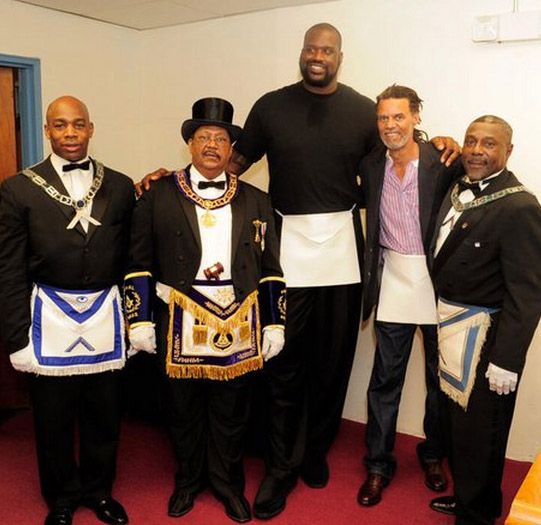
Many people have been members of the fraternity of Freemasons over the years. That includes people from all walks of life, including professional athletes. These men became brothers and shining examples of the positive impact that Freemasonry has on each member.
Famous Athletes who are Freemasons:
Arnold Palmer – Golf
1929 – 2016
Is a 33′ Mason who joined Loyalhanna Lodge No. 275 F&AM in Latrobe, Pennsylvania
Ty Cobb – MLB Baseball
1886 – 1961
Was a member of Royston Lodge No. 426 F&AM in Detroit, Michigan
Honus Wagner – MLB baseball
1874 – 1955
Became a Freemason at Centennial Lodge No. 544 F&AM in Carnegie, Pennsylvania
Shaquille O’Neal – NBA Basketball
Born 1972
Is a member of Widow’s Son Lodge No.28 PHA in Boston, Massachusetts
Scottie Pippen – NBA Basketball
Born 1965
Is a member of Unity Lodge No.454 PHA in Arkansas
James Naismith – Inventor of the Sport of Basketball
1861 – 1939
Became a Freemason at Russell Lee Lodge in Springfield, Massachusetts
Tim Horton – NHL Hockey
1930 – 1974
Was a member of Kroy Lodge No. 676 in Toronto, Ontario, Canada
John Elway Jr. – NFL Football
Born 1960
Became a Freemason in January 2002 at South Denver Masonic Lodge No. 93 F&AM in Denver, Colorado
Sugar Ray Robinson – Boxing
1921 – 1989
Was a member of Joppa Lodge #55 PHA in New York City, New York
Manny Pacquiao – Boxing
Born 1978
Has been initiated as an Entered Apprentice in March, 2021 at Mamamayang Pilipino Lodge in the Philippines.
Joe Frazier – Boxing
1944 – 2011
Became a Freemason in March 2009 at M.B. Taylor Lodge No. 141 F&AM in Hammonton, New Jersey
Jack Dempsey – World Heavyweight Champion
1895 – 1983
Was a member of Kenwood Lodge No. 800 AF&AM in Chicago, Illinois
More Info:
https://scottishritenmj.org/blog/sporting-gold-masonic-athletes
Tall Cedars of Lebanon
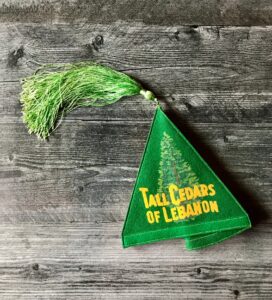
This is an appendant body, or side degree, of Freemasonry. It devotes itself to friendship and brotherly love towards fellow Masons and all mankind. They are currently over 10,000 members strong and their chapters are mostly located in the Northeast of the United States. The individual members are called cedars, who in turn meet in chapters called forests. The national body is named the Supreme Forest.
“It all started in 1843 with some very energetic and imaginative Master Masons who dreamed up the idea of a Tall Cedar Degree, and in those days the degree was called ” The Ancient and Honorable Rite of Humility.” The name “Tall Cedar Degree” does not reveal itself other than the possibility of a somewhat shorter title than the aforementioned, and this was to remain as such until we adopted the title of ” Tall Cedars of Lebanon of the United States of America” upon incorporation in 1902.”
The official creed is: ” Fun Frolic & Fellowship”
Like most appendant bodies in Freemasonry, there is a designated charity for this organization. The Tall Cedars support research into Muscular Dystrophy and other neuromuscular diseases. It is estimated that the Tall Cedars have raised over $14-million for Muscular Dystrophy research. Each year, the Supreme Forest presents a check at the Jerry Lewis Labor Day Telethon.
More Info:
https://en.wikipedia.org/wiki/Tall_Cedars_of_Lebanon
https://www.tallcedars.org
Tiler’s Sword
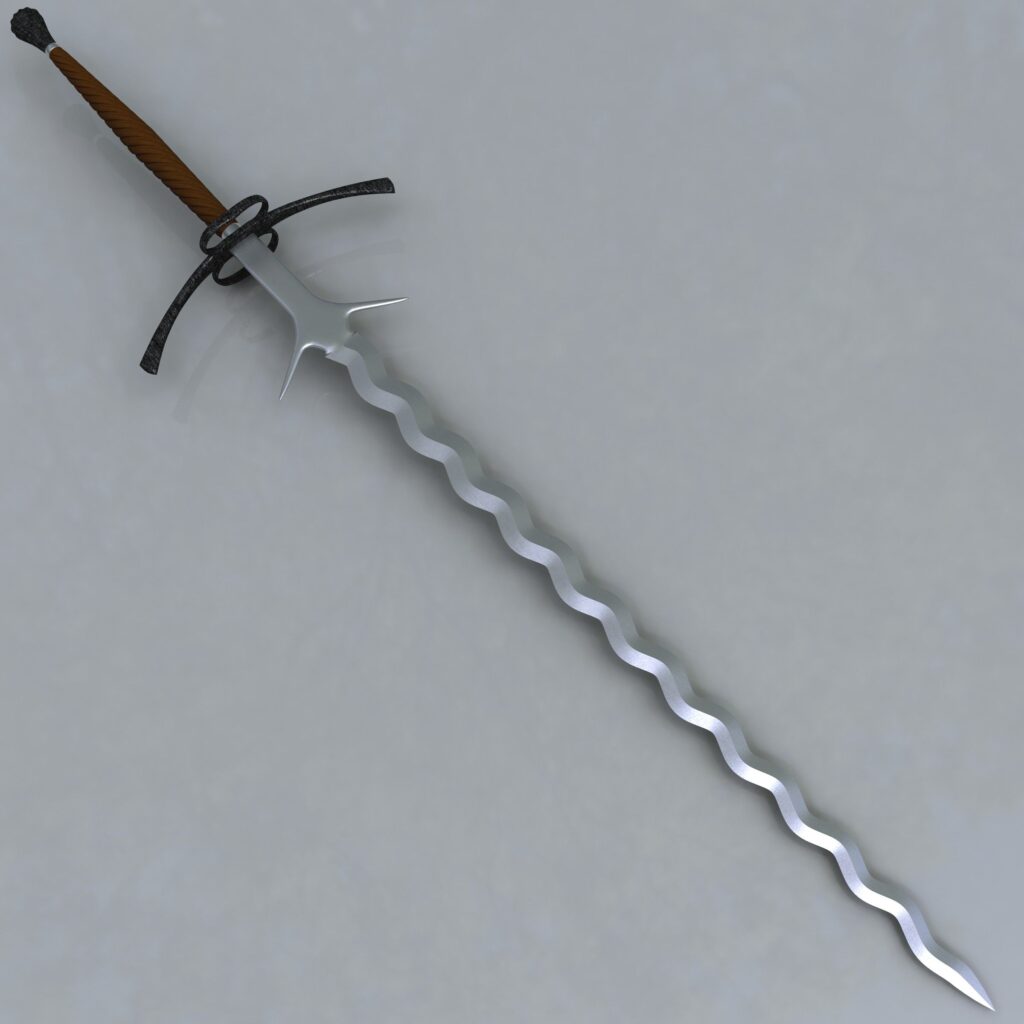
The tiler is an officer of the Masonic lodge. His duty is to guard the closed doors of the lodge room from the approach and attempted entry of all non-approved individuals. This constitutes mostly non-Masons. But it can also mean Masons that are not in good standing, or who are not of the appropriate degree. Not in good standing means that their dues are not current. Being of the wrong degree means that the lodge has been opened in a higher degree, such as Master Mason, and the person trying to enter not having attained that level yet.
One hypothesis of the origin of the word tiler is that it derives from the tiles used in operative Masonry, that were used to seal the structural masonry, whether they be on floors, walls or roofs. Likewise, the tiler seals the activities of the lodge.
The tiler uses a drawn sword to represent his office. This sword can not be in a scabbard. He proceeds at the beginning of the lodge meeting from the altar to his station outside the doors brandishing this weapon. Once outside he sets up, ready to defend the lodge.
Traditionally the tiler’s sword used to be a flamberge, a large bladed sword, also known as a flaming sword.
This is in allusion of the flaming sword that was placed at the East side of the Garden of Eden, which turned every way to keep the way of the Tree of Life. Genesis (iii, 4): “So he drove out the man; and he placed at the east of the garden of Eden cherubim’s and a flaming sword which turned every way, to keep the way of the tree of life;” or, as Raphael has translated it, “the flaming sword which revolveth, to guard the way to the tree of life.” Today most lodge use a regular straight bladed sword instead.
The Tiler has not been armed with a sword through all of Masonic history. In early Freemasonry, the Tiler was “armed with the proper implement of his office,” which was appropriately, a trowel used for setting tiles.
More Info:
https://en.wikipedia.org/wiki/Flame-bladed_sword
https://thecraftsman.org/wp-content/uploads/2020/01/DONE-The-Tyler-JB.pdf
https://www.masonicworld.com/education/files/artnov01/The%20Sword%20in%20the%20Craft.htm
Gloves
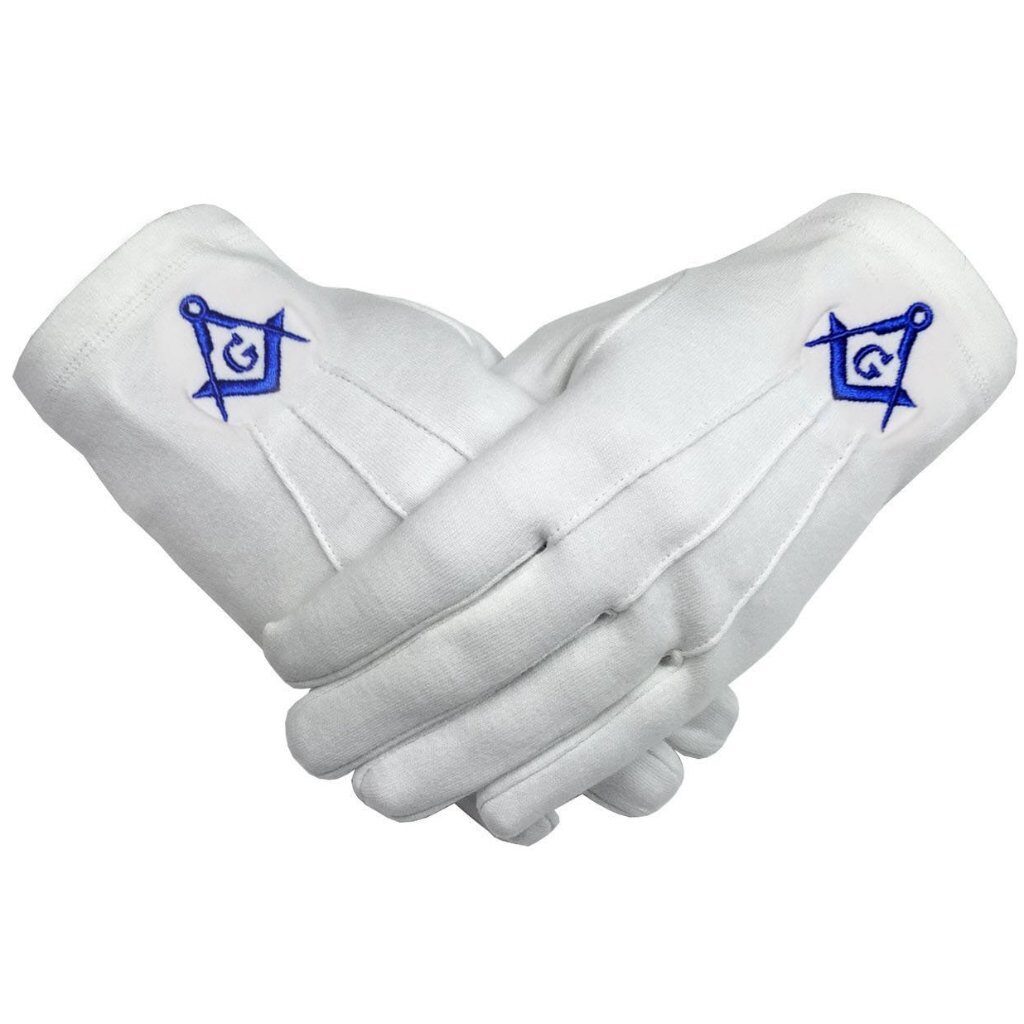
Why do Masons wear white gloves? This question leads to a lot of symbolism, a lot of which most Masons might not be aware of either. At first glance the gloves might appear to be very elitist and snobbish. However, instead of being a source of separation where the wearer uses them to indicate a higher station in life, Masonic gloves are intended to do the opposite.
Freemasons are a fraternity that invites men from all walks of life. The ranks include physical laborers such as farmers, car mechanics and construction workers, as well as white color jobs such as bankers, teachers, entrepreneurs and scientists. Freemasonry teaches us that it is the internal and not the external qualities that make a Mason. By wearing gloves it disguises whether or not the hands of a particular brother might be smooth or rough. The brethren strive for brotherly love and equality.
It also adds a certain atmosphere of dignity and decorum.
The color white itself symbolizes innocence and purity of heart and mind. It reminds the Masons to always do what is moral and right.
“The first recorded evidence of white gloves being worn by a freemason comes from the
records of the Kilwinning Lodge in Ayrshire, Scotland of January 15, 1599. Still presented to new initiates in England, they are accompanied with the explanation that the white of the gloves represents innocence and purity, symbolically denoting a purity of action, rectitude of conduct, and a never-ending argument for higher thoughts, nobler deeds, and greater achievements.”
In early Christian churches the clergy wore gloves to indicate that their hands were clean and devoid of bribery. To this day the pope and his dignitaries still wear white gloves during official ceremonies of the Roman Catholic Church.
The washing of hands as a ritual of purification has a long tradition and can be found as far back as ancient Greece in the story of Midas and the golden touch. Where Dionysus orders King Midas to wash his hands in the river Pactolus to reverse the curse. The white gloves are a symbolic representation of such a purification.
More Info:
https://freemasonry.bcy.ca/masonic_bulletin/66/lxvi03.pdf
Eye of Providence
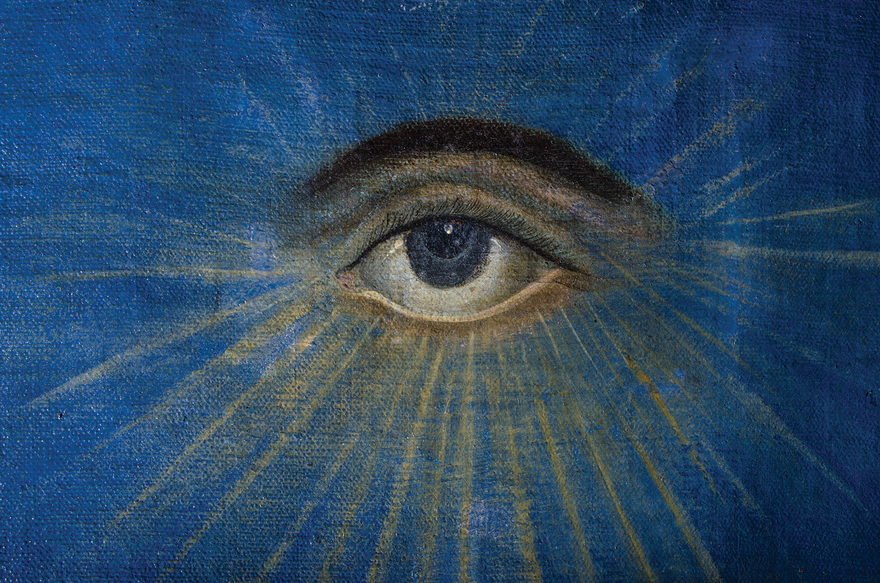
This eye is known by many names. It is referred to as the masonic eye, third eye, or eye of the universe. In the combination with rays that emanate outwardly it represents the sun as the source of all the light. Masonically light represents knowledge and truth.
In ancient times the eye was used as a symbol of the Egyptian god Horus. He gave his eye to Osiris to help rule the underworld. Osiris ate the eye and was returned to life. Thus, the eye was seen as a symbol of life and resurrection.
In more recent history, more specifically the Renaissance period, the eye was commonly called the all-seeing eye, or eye of providence. This has been a very Christian icon. The eye invokes the ever-present watchful eye of god that sees and knows all. It reminds us to follow God’s teachings and maintain his moral standards. This interpretation is supported by the following quote of the bible from Proverbs 15:3, “The eyes of the lord are in every place beholding the evil and the good.” The rays represent God’s omnipresent glory that radiates outward into the darkest corners of life. It also demonstrates a form of spiritual illumination or revelation. Providence refers to the Christian concept of divine guidance. Therefore, the symbol of the eye is meant to show the pious believer the righteous way.
These depictions of the all-seeing eye are exceedingly common in European Renaissance art and church iconography. Most churches constructed during that time have depictions of this symbol in a prominent placement, most commonly above the altar or above a statue of Jesus Christ.
Well after the renaissance period had ended, and the enlightenment period was in full swing was when Freemasons officially started to incorporate the symbol. The earliest recognized use of the all-seeing eye in freemasonry was in 1797 when it appeared in the publication of Thomas Smith Webb’s The Freemason’s Monitor. Here the eye is meant to remind the mason that his actions never go unseen. The Grand Architect of the Universe is ever watchful. An earlier use of the eye of providence by a freemason was by the first known non-operative “gentleman mason”, Sir Robert Moray. He became the first real speculative “freemason” when he was admitted to the Lodge of Edinburgh on May 20, 1641. His official personal private seal included a radiant eye. “This seal has been preserved on a letter from Robert Moray to the Earl of Essex, now in the British Library, London.” (Ovason, Secret Symbols of Dollar Bill, 57)
The most famous use of the all-seeing-eye is on the One-dollar bill of the United States of America. It displays the Great Seal of the United States, which itself was based on a design created by William Barton of Philadelphia, when it was created in 1782. Considering that the Great Seal, as well as the design for the one-dollar bill were published seventeen years before Bro. Webb’s The Freemason’s Monitor, it is safe to assume that the popular conspiracy theories regarding the currency indicating a masonic connection are at best fanciful. The most likely explanation is that this use indicates the deep Christian ideals that the founders of this nation, as well as the artist William Barton held.